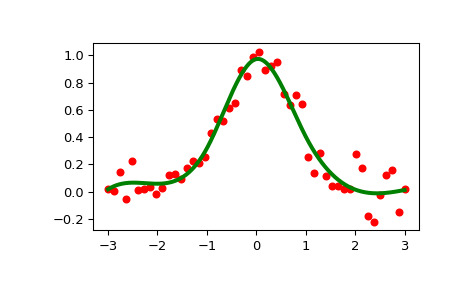本文简要介绍 python 语言中 scipy.interpolate.LSQUnivariateSpline 的用法。
用法:
class scipy.interpolate.LSQUnivariateSpline(x, y, t, w=None, bbox=[None, None], k=3, ext=0, check_finite=False)#具有显式内部结的一维样条。
将 k 次的样条 y = spl(x) 拟合到提供的 x, y 数据。 t 指定样条的内部结点
- x: (N,) 数组
数据点的输入维度 - 必须增加
- y: (N,) 数组
数据点的输入维度
- t: (M,) 数组
样条的内部结。必须按升序排列并且:
bbox[0] < t[0] < ... < t[-1] < bbox[-1]- w: (N,) 数组, 可选
样条拟合的权重。必须是正的。如果无(默认),则权重均为 1。
- bbox: (2,) 类数组,可选
2-sequence 指定近似区间的边界。如果无(默认),
bbox = [x[0], x[-1]]。- k: 整数,可选
平滑样条的度数。必须为 1 <= k <= 5。默认值为 k = 3,即三次样条。
- ext: int 或 str,可选
控制不在节点序列定义的区间内的元素的外推模式。
如果 ext=0 或 ‘extrapolate’,则返回外推值。
如果 ext=1 或 ‘zeros’,返回 0
如果 ext=2 或‘raise’,则引发ValueError
如果‘const’的ext=3,返回边界值。
默认值为 0。
- check_finite: 布尔型,可选
是否检查输入数组是否仅包含有限数。禁用可能会提高性能,但如果输入确实包含无穷大或 NaN,则可能会导致问题(崩溃、非终止或无意义的结果)。默认为假。
- ValueError
如果内部结不满足 Schoenberg-Whitney 条件
参数 ::
抛出 ::
注意:
数据点的数量必须大于样条度 k。
结t必须满足Schoenberg-Whitney条件,即必须有数据点的子集
x[j]这样t[j] < x[j] < t[j+k+1], 为了j=0, 1,...,n-k-2.例子:
>>> import numpy as np >>> from scipy.interpolate import LSQUnivariateSpline, UnivariateSpline >>> import matplotlib.pyplot as plt >>> rng = np.random.default_rng() >>> x = np.linspace(-3, 3, 50) >>> y = np.exp(-x**2) + 0.1 * rng.standard_normal(50)用预定义的内部结拟合平滑样条:
>>> t = [-1, 0, 1] >>> spl = LSQUnivariateSpline(x, y, t)>>> xs = np.linspace(-3, 3, 1000) >>> plt.plot(x, y, 'ro', ms=5) >>> plt.plot(xs, spl(xs), 'g-', lw=3) >>> plt.show()
检查节点向量:
>>> spl.get_knots() array([-3., -1., 0., 1., 3.])使用来自另一个样条的结构造 lsq 样条:
>>> x = np.arange(10) >>> s = UnivariateSpline(x, x, s=0) >>> s.get_knots() array([ 0., 2., 3., 4., 5., 6., 7., 9.]) >>> knt = s.get_knots() >>> s1 = LSQUnivariateSpline(x, x, knt[1:-1]) # Chop 1st and last knot >>> s1.get_knots() array([ 0., 2., 3., 4., 5., 6., 7., 9.])
相关用法
- Python SciPy interpolate.LSQSphereBivariateSpline用法及代码示例
- Python SciPy interpolate.LinearNDInterpolator用法及代码示例
- Python SciPy interpolate.make_interp_spline用法及代码示例
- Python SciPy interpolate.krogh_interpolate用法及代码示例
- Python SciPy interpolate.InterpolatedUnivariateSpline用法及代码示例
- Python SciPy interpolate.BSpline用法及代码示例
- Python SciPy interpolate.griddata用法及代码示例
- Python SciPy interpolate.splder用法及代码示例
- Python SciPy interpolate.PPoly用法及代码示例
- Python SciPy interpolate.NdBSpline用法及代码示例
- Python SciPy interpolate.pade用法及代码示例
- Python SciPy interpolate.barycentric_interpolate用法及代码示例
- Python SciPy interpolate.RegularGridInterpolator用法及代码示例
- Python SciPy interpolate.NdPPoly用法及代码示例
- Python SciPy interpolate.interp2d用法及代码示例
- Python SciPy interpolate.approximate_taylor_polynomial用法及代码示例
- Python SciPy interpolate.RectSphereBivariateSpline用法及代码示例
- Python SciPy interpolate.sproot用法及代码示例
- Python SciPy interpolate.splantider用法及代码示例
- Python SciPy interpolate.CloughTocher2DInterpolator用法及代码示例
- Python SciPy interpolate.interp1d用法及代码示例
- Python SciPy interpolate.BPoly用法及代码示例
- Python SciPy interpolate.BarycentricInterpolator用法及代码示例
- Python SciPy interpolate.splrep用法及代码示例
- Python SciPy interpolate.make_smoothing_spline用法及代码示例
注:本文由纯净天空筛选整理自scipy.org大神的英文原创作品 scipy.interpolate.LSQUnivariateSpline。非经特殊声明,原始代码版权归原作者所有,本译文未经允许或授权,请勿转载或复制。
